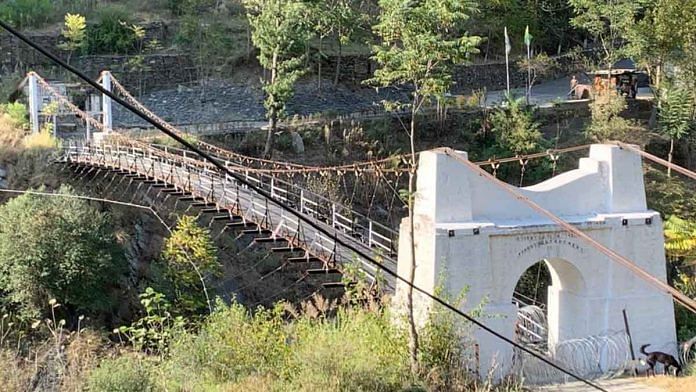Tithwal (Kupwara): Constantly under the shadow of enemy snipers, residents of Tithwal village, the second-last village along the Line of Control (LoC) in Kupwara district of Jammu and Kashmir, are hoping tensions ease in the region so mobility between the village and Pakistan-occupied Kashmir (PoK) could resume.
The Tithwal crossing bridge, which is right on the LoC and spans the Kishanganga river, has been shut since 2018 due to increased tensions between India and Pakistan. Since then, anyone that approaches the bridge is a target of Pakistani snipers.
First constructed in 1931, the bridge is a standing symbol of the separation of families on both sides of the border and the fraught relations between the two countries it connects.
It was originally constructed by the British, but was destroyed in 1948 when Pakistan attempted to occupy Kashmir. However, in 1988, the bridge was reconstructed jointly by India and Pakistan.
The bridge is one of the five crossing points along the LoC that India and Pakistan had opened in 2005 to allow separated Kashmiri families to visit each other.
It had collapsed during the 2005 earthquake but was rebuilt by both sides the same year.
While the Indian side of the gate is built with cement and concrete, the Pakistani side has an iron gate. A white line, in the middle of the bridge, separates India from the Neelam Valley of PoK.
Whenever there are visitors to the bridge, the Indian side informs the Pakistani soldiers on the other side on a local hotline so they don’t open fire.
Also read: Short gun-fights, less stone-pelting — Kashmir counter-terror ops changing, says Army officer
Living under shadow of Pakistani snipers
The residents of the village, who are mostly Paharis and Gujjars, have witnessed intense shelling over the years since the village is located ahead of the anti-infiltration fence of the Army.
Since the shutting of the bridge in 2018, the villagers have also been under the shadow of Pakistani snipers.
While no fatalities have been reported so far, two local residents who were making community bunkers for themselves in the adjoining Simari village were shot at by Pakistani snipers in July this year.
One was shot in the stomach and barely survived while the other was shot in the leg.
“I was just making a community bunker for the protection of my family and other villagers on 8 July this year, and I was shot because Pakistani soldiers wanted to stop us,” 26-year-old Zameer Ahmed told ThePrint.
Ahmed now walks with a waste bag pinned to his stomach after his intestines were damaged in the incident.
According to the villagers, it is a nightmare when shells are flying over their heads because they fear that any one of them could drop into their houses.
Also read: Shopian encounter is Manoj Sinha’s litmus test. Justice can act as bridge to Kashmir
‘Hope the bridge reopens’
Ejaz Ahmed, an elder from the village, said the bridge was a connection between families on both sides. He said the government used to issue a crossing permit to local residents, which would be valid for 15 days and could be extended by another two months.
The permit used to be issued by the passport office after following all background checks.
“We have families living across (the bridge). The permit enabled us to visit them. However, since 2018, the crossing has been shut,” he told ThePrint.
The Tithwal village has also been selected as a ‘model village’, though residents note that much more needs to be done to develop it.
“This is a model village but we don’t get mobile connectivity. We have to walk out of the village, around 150 metres, to get a connection,” said a resident.
Incidentally, unlike the rest of the border areas, the village has proper houses made of cement and the residents are also seemingly well-off.
However, security forces believe a share of narcotics, which has become a rising concern in Jammu and Kashmir in recent times, is smuggled in through the Neelam valley area in PoK and through such border villages.
Also read: India says China has no ‘locus standi’ to speak on Jammu & Kashmir and Ladakh



